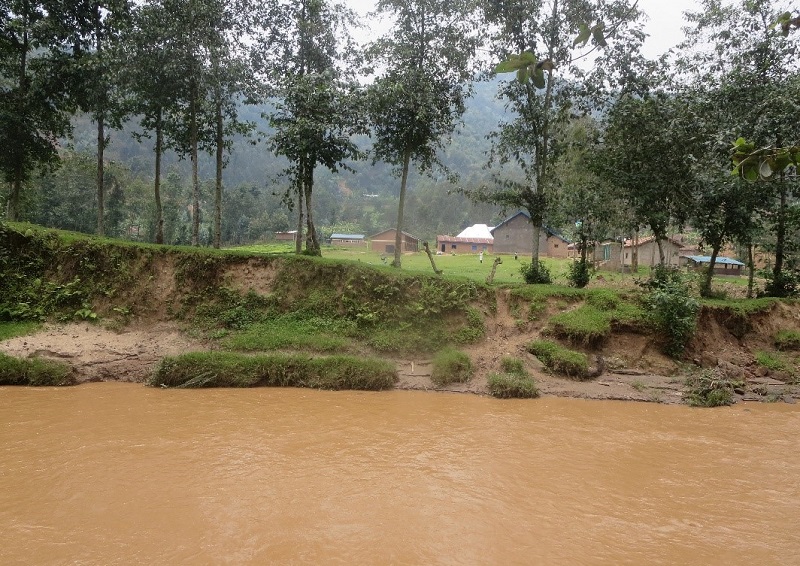Bridges to Prosperity programme
Contents |
[edit] Introduction
Young engineers will be working on the Bridges to Prosperity programme to help build infrastructure to connect people in developing countries, but need the support of the engineering community to help fund this vital work.
Rural isolation is often cited as a root cause of poverty. Connecting communities to essential education, healthcare facilities and economic opportunity is one of the cornerstones of social development and genuinely life-changing.
COWI UK has teamed up with WilkinsonEyre Architects to build its fifth bridge in Rwanda with the charity Bridges to Prosperity (B2P). The Kazabe footbridge will be a great help for the local community and create safe, all year-round access to facilities, schools and markets.
[edit] Building connections to development
Almost 1 billion people around the world don't have safe access to critical resources like healthcare, education, or employment due to an impassable river.
With a single innovation, a bridge can have an impact on households across multiple dimensions.
When a community has year-round access to key resources like healthcare, education, markets and employment, residents have greater freedom - freedom to choose how they better their lives.
Safe access unlocks economic opportunity for a community. Farmers are able to sell their crops at outside markets or access agricultural inputs like fertiliser or seed. Bridges ensure consistent access to non-agricultural jobs. Women save time on household activities, spurring an increase in women entering the work force.
Last-mile connectivity goes beyond transforming local economies. When a rural community is networked to the world around them, they participate in the national and global economy, bringing transformation to the greater population as well as to their local community.
This is where a bridge can help.
[edit] About the Kazabe project
The residents of the Kigarama-Musabike community farm tea, beans, maize, and sweet potatoes and sell their goods at the market to provide for their families.
Currently, the crossing is used primarily by students, who must cross in order to access primary and secondary schools, and tea plantation workers.
The Sebeya River is impassable 45 days out of the year, and hence, students cannot attend school, the tea plantation workers cannot safely get to work, and residents are isolated from the nearest health centre and market.
The 43 m Kazabe Suspension Bridge will provide safe, year-round access for the members of the communities who live nearby.
By providing reliable access to critical services, the bridge will transform not only the communities’ pedestrian routes but also their potential to thrive.
[edit] Help fund the Kazabe, Rwanda project
Engineers will travel this month to Rwanda to help build the bridge, but they need the financial support of the engineering community to do so.
[edit] Bridges built to last
[edit] Durability and sustainability
As leading bridge builders in the international development space, B2P designs, builds and maintains durable and environmentally sustainable bridges that provide safe access for generations.
It has spent years perfecting bridge designs and sustainable construction models, so engineers can work in any country efficiently and effectively.
All of the bridges are designed to be resilient to extreme weather events, with locally sourced and donated materials.
[edit] Technical inspection and maintenance
Professionals from around the world volunteer their time and resources to return to project communities, inspecting footbridges and providing support for upkeep.
Local residents also commit to maintain and inspect the bridge, and are trained to do so.
This article was originally published here by ICE on 15 Nov 2018. It was written by Balint Penzes, COWI.
--The Institution of Civil Engineers
[edit] Related articles on Designing Buildings Wiki
Featured articles and news
RTPI leader to become new CIOB Chief Executive Officer
Dr Victoria Hills MRTPI, FICE to take over after Caroline Gumble’s departure.
Social and affordable housing, a long term plan for delivery
The “Delivering a Decade of Renewal for Social and Affordable Housing” strategy sets out future path.
A change to adoptive architecture
Effects of global weather warming on architectural detailing, material choice and human interaction.
The proposed publicly owned and backed subsidiary of Homes England, to facilitate new homes.
How big is the problem and what can we do to mitigate the effects?
Overheating guidance and tools for building designers
A number of cool guides to help with the heat.
The UK's Modern Industrial Strategy: A 10 year plan
Previous consultation criticism, current key elements and general support with some persisting reservations.
Building Safety Regulator reforms
New roles, new staff and a new fast track service pave the way for a single construction regulator.
Architectural Technologist CPDs and Communications
CIAT CPD… and how you can do it!
Cooling centres and cool spaces
Managing extreme heat in cities by directing the public to places for heat stress relief and water sources.
Winter gardens: A brief history and warm variations
Extending the season with glass in different forms and terms.
Restoring Great Yarmouth's Winter Gardens
Transforming one of the least sustainable constructions imaginable.
Construction Skills Mission Board launch sector drive
Newly formed government and industry collaboration set strategy for recruiting an additional 100,000 construction workers a year.
New Architects Code comes into effect in September 2025
ARB Architects Code of Conduct and Practice available with ongoing consultation regarding guidance.
Welsh Skills Body (Medr) launches ambitious plan
The new skills body brings together funding and regulation of tertiary education and research for the devolved nation.
Paul Gandy FCIOB announced as next CIOB President
Former Tilbury Douglas CEO takes helm.
UK Infrastructure: A 10 Year Strategy. In brief with reactions
With the National Infrastructure and Service Transformation Authority (NISTA).
























